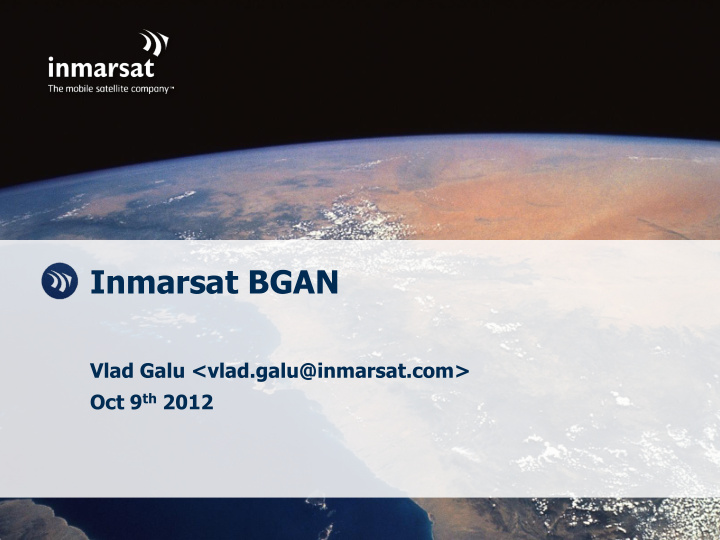



Inmarsat BGAN Vlad Galu <vlad.galu@inmarsat.com> Oct 9 th 2012
What is BGAN? • Worldwide L-band 3G service • Launched 2005 • Data • Voice • SCADA • US DoD • News agencies • Oil & gas • Maritime • Charity/humanitarian organizations 2
Challenges Latency Average RTTs of 1100ms (normal mode) and 800ms (streaming mode) Legacy systems used by customers Default receive window sizes too small No SACK support TCP Tahoe/Reno not effective in laggy & lossy environments Slow start: congestion window increases by the number of acknowledged bytes. Performs poorly with short lived connections Packet loss -> congestion window resets, entering the congestion avoidance phase (linear growth) 3
Solutions Inmarsat TCP-PEP Inline transparent TCP enhancing proxy providing L3 acceleration Fast start Large receive window sizes (128KB) SACK TCP timestamps TCP Vegas (delay-based congestion control) LZ77 payload compression End to end capability negotiation using TCP options MVNOs to provide L7 acceleration as a product differentiator 4
Integration – end to end 5
Integration - client side 6
Integration - network side Iu: ATM encapsulation. Expensive, both hardware and software-wise Gi: Traffic is encrypted GGSN: operational overhead: many MVNOs in 3 PoPs Gn: Traffic is not encrypted, access to GPRS data 7
Where we are today Shifting focus Better default TCP/IP stacks (CTCP, Westwood+, CUBIC) Customers (slowly) upgrading to new OS versions Internet servers have large initial congestion windows Web content much richer than in 2005 L7 acceleration not widely deployed by MVNOs Inmarsat becoming a fully-fledged ISP, looking at deploying L7 accelerators JS/CSS amounting to ~½ of an average page load time HTTP request coalescing, lossy JPEG compression, text trimming 8
Where we are today More challenges RFC1918 overlap: MVNOs use 10/8 Off-the-shelf L7 accelerators do not support GPRS Deploying at the PoP: expensive, requires several accelerators Deploying at the GGSN: operational overhead, many MVNOs in 3 PoPs Deploying alongside TCP-PEP: feasible, still requires NAT 9
Where we go tomorrow 2013: Inmarsat Global Xpress K a -band broadband network: End-user service support Up to 50Mbps downstream/up to 5Mbps upstream Lower latency Larger terminals – 0.6m to 2.4m aperture Built-in L3 acceleration based on real-time hints from the OTA interface IPv6 BGAN/GX coexistence Shared MVNO interconnections L7 acceleration platforms could be used by both BGAN & GX 10
Thank you! 11
Recommend
More recommend